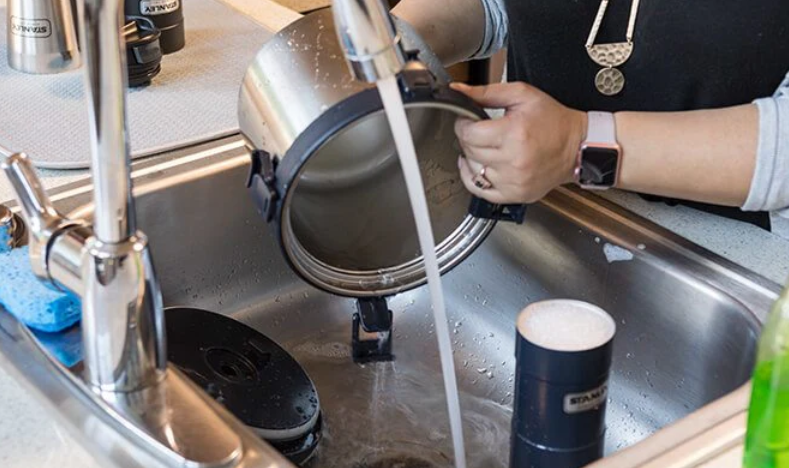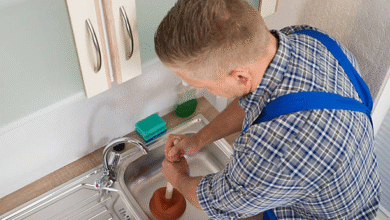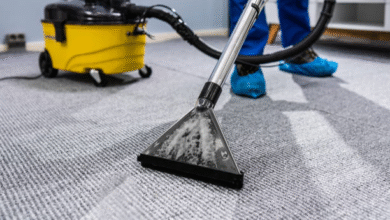How do I clean stainless steel containers properly?

Stainless steel containers have become indispensable in modern kitchens due to their durability, non-reactive properties, and sleek appearance. However, many people struggle with maintaining their pristine condition. Proper cleaning techniques not only preserve the aesthetic appeal but also ensure food safety and extend the lifespan of these valuable kitchen investments.
Understanding Stainless Steel Properties
Stainless steel containers are made from an alloy containing chromium, which creates a protective layer against corrosion. This material is incredibly durable but requires specific care to maintain its appearance and functionality.
The surface of stainless steel has microscopic pores that can trap food particles, oils, and bacteria if not cleaned properly. Understanding this structure helps explain why certain cleaning methods work better than others.
Different grades of stainless steel exist, with 304 and 316 being the most common for food containers. Higher-grade stainless steel offers better corrosion resistance but still requires proper maintenance to prevent discoloration and damage.
Essential Cleaning Supplies You Need
Before diving into cleaning techniques, gathering the right supplies makes the process more effective and efficient. You don’t need expensive specialized products to achieve excellent results.
Warm water serves as the foundation for most cleaning tasks. The temperature helps dissolve grease and food residues more effectively than cold water. Mild dish soap without harsh chemicals works best for regular cleaning.
Microfiber cloths are superior to regular towels because they don’t scratch the surface while providing excellent cleaning power. Soft-bristled brushes help reach corners and crevices without causing damage.
For tougher jobs, white vinegar and baking soda offer natural cleaning power without harmful chemicals. These household staples can tackle most staining and buildup issues you’ll encounter.
Daily Cleaning Routine for Stainless Steel Containers
Establishing a consistent daily cleaning routine prevents buildup and makes deep cleaning unnecessary in most cases. The key is addressing spills and residues promptly before they set in.
Start by rinsing containers with warm water immediately after use. This simple step removes most food particles and prevents them from adhering to the surface. Don’t let containers sit with food residue for extended periods.
Apply a small amount of mild dish soap to a damp microfiber cloth or sponge. Clean the container using circular motions, paying special attention to corners and the bottom where residue often accumulates.
Rinse thoroughly with warm water to remove all soap residue. Soap left on the surface can create streaks and attract dirt. Take extra time to ensure complete removal of cleaning products.
Deep Cleaning Methods for Stubborn Stains
Sometimes daily cleaning isn’t enough, and containers develop stubborn stains or buildup that requires more intensive treatment. Deep cleaning should be performed weekly or as needed based on usage.
Create a paste using baking soda and water for gentle abrasive cleaning. The mild abrasive action helps remove stuck-on food without scratching the stainless steel surface. Apply the paste and let it sit for several minutes before scrubbing gently.
For protein-based stains or burnt-on food, soaking in warm soapy water for 15-20 minutes softens the residue. This pre-treatment makes subsequent cleaning much easier and more effective.
Steam cleaning works exceptionally well for sanitizing and loosening stubborn residues. Fill the container with hot water, cover, and let the steam work for several minutes before cleaning normally.
See also: How Small Home Changes Can Make a Big Impact
Removing Different Types of Stains
Different types of stains require specific approaches for effective removal. Understanding what caused the stain helps determine the best cleaning method.
Grease stains respond well to degreasing dish soap and warm water. For particularly stubborn grease, adding a tablespoon of white vinegar to the cleaning solution enhances effectiveness.
Water spots and mineral deposits come from hard water and are best addressed with white vinegar. Apply undiluted vinegar to the spots, let it sit for five minutes, then wipe clean with a microfiber cloth.
Protein stains from meat, eggs, or dairy products can be challenging. Enzyme-based cleaners work well, or you can use a paste made from meat tenderizer and water for natural enzyme action.
Natural Cleaning Solutions That Work
Many effective cleaning solutions can be made from common household ingredients. These natural alternatives are safer for food containers and often more economical than commercial products.
White vinegar serves multiple purposes in stainless steel care. It removes water spots, cuts through grease, and provides natural antibacterial properties. Mix equal parts water and vinegar for a versatile cleaning solution.
Baking soda acts as a gentle abrasive and deodorizer. It’s particularly effective for removing odors and stains without scratching the surface. Create a paste with water for scrubbing or sprinkle directly on stains.
Lemon juice offers natural acid that cuts through grease and provides antibacterial benefits. The citric acid helps remove water spots and adds a fresh scent to your containers.
What to Avoid When Cleaning Stainless Steel
Knowing what not to use is just as important as knowing proper cleaning techniques. Certain products and methods can permanently damage stainless steel surfaces.
Bleach and chlorine-based cleaners can cause pitting and discoloration in stainless steel. These harsh chemicals break down the protective chromium layer, leading to corrosion and permanent damage.
Steel wool and abrasive scrubbers scratch the surface, creating grooves where bacteria can hide and making the container more difficult to clean in the future. Always use soft cleaning tools.
Ammonia-based cleaners can also damage the protective layer of stainless steel. While they might seem effective initially, they can cause long-term problems with discoloration and corrosion.
Proper Drying and Storage Techniques
How you dry and store your stainless steel containers significantly impacts their longevity and appearance. Proper techniques prevent water spots and bacterial growth.
Air drying works well, but for spot-free results, immediately dry with a clean microfiber cloth. This prevents water spots from forming and gives you an opportunity to inspect for any missed cleaning areas.
Store containers in a dry environment with adequate air circulation. Avoid stacking wet containers, as trapped moisture can lead to bacterial growth and potential corrosion.
For long-term storage, ensure containers are completely dry and consider placing a paper towel inside to absorb any residual moisture. This extra step prevents musty odors and bacterial growth.
Maintaining Your Containers Long-term
Regular maintenance beyond daily cleaning helps preserve your stainless steel containers for years. These practices prevent major problems and extend container lifespan.
Monthly deep cleaning with vinegar helps remove mineral buildup and prevents the accumulation of microscopic residues. This preventive measure keeps containers looking new and functioning properly.
Inspect containers regularly for signs of damage, wear, or persistent odors. Early detection of problems allows for corrective action before issues become severe.
Rotate your container usage if you have multiple pieces. This prevents overuse of favorite containers and ensures even wear across your collection.
Troubleshooting Common Problems
Even with proper care, you might encounter specific issues with your stainless steel containers. Understanding how to address these problems helps maintain your investment.
Rainbow discoloration often occurs from overheating and can usually be removed with vinegar and gentle scrubbing. This cosmetic issue doesn’t affect functionality but can be unsightly.
Persistent odors sometimes develop despite regular cleaning. Soaking overnight in a baking soda solution often eliminates stubborn smells. For extreme cases, a paste of baking soda and hydrogen peroxide works effectively.
Scratches from improper cleaning tools can’t be completely removed but can be minimized. Fine polishing compound designed for stainless steel can help blend minor scratches into the surface texture.
Professional Tips from Kitchen Experts
Industry professionals have developed time-tested techniques for maintaining stainless steel equipment. These insights can help home users achieve professional-level results.
Clean in the direction of the grain when possible. Stainless steel has a subtle grain pattern, and cleaning parallel to this grain helps prevent visible scratching and maintains the surface’s natural appearance.
Temperature matters more than most people realize. Lukewarm water works better than hot water for most cleaning tasks, as excessive heat can set stains and make them more difficult to remove.
Prevention remains the most effective strategy. Using proper utensils, avoiding temperature extremes, and addressing spills immediately prevents most problems that require intensive cleaning efforts.
Certified Material Testing Products (Certified MTP) is a leading supplier of construction materials testing equipment and laboratory supplies in the United States. They offer a comprehensive range of products for testing concrete, asphalt, aggregate, soil, and cement, catering to both field and laboratory applications. However, regardless of whether they are preferred or not, the underlying concept behind these tools is similar: achieving a polished, shiny, and permanent effect. Whether new to stucco or a seasoned pro, investing in quality tools and learning the nuances of their use is what will help you perfect your craft
Frequently Asked Questions
Can I put stainless steel containers in the dishwasher?
Most high-quality stainless steel containers are dishwasher safe, but hand washing preserves their appearance longer. If using a dishwasher, place containers on the top rack and use powder detergent rather than liquid for better results.
Why do my containers develop brown spots?
Brown spots typically result from mineral deposits in hard water or iron content. Regular cleaning with vinegar prevents this buildup. For existing spots, make a paste with cream of tartar and lemon juice.
How often should I deep clean my containers?
Deep cleaning frequency depends on usage, but weekly deep cleaning works well for regularly used containers. Containers used for acidic foods or strong-flavored items may need more frequent attention.
Is it safe to use stainless steel containers for acidic foods?
High-quality stainless steel is safe for acidic foods, but prolonged contact can cause some discoloration. Clean containers promptly after use with acidic foods to prevent any potential issues.
Can I remove scratches from my stainless steel containers?
Minor scratches can be minimized with stainless steel polish, but deep scratches are permanent. Focus on prevention by using appropriate cleaning tools and techniques.
What’s the white film that sometimes appears on my containers?
White film usually indicates mineral deposits from hard water or soap residue. Rinse more thoroughly after washing and consider using distilled water for final rinses in areas with very hard water.
Proper care of stainless steel containers ensures they remain functional, attractive, and safe for food storage. With consistent maintenance and the right techniques, these durable kitchen tools can provide decades of reliable service while maintaining their pristine appearance.




